I’m sure I can’t expect everyone to be as excited about this recipe as I am. Many of you probably already do this with a yogurt maker, or some other method, and know more about the process than I. But I want to share because I’m thrilled to find this so simple.
I have been on a brutally restrictive diet since the beginning of December. One of the few things I can tolerate besides chicken stock and vegetables is yogurt. Since that’s the case, I want to be eating the most wholesome yogurt I can. I’m using regular whole milk from the grocery store, but by making my own yogurt I can be sure of exactly what else is in it. Fresh milk would no doubt be ideal, but I don’t have reliable access to affordable milk. The good brands of yogurt at our local health food stores cost from $5-$7 a quart. Once I honed my method, I figured this is costing me less than $1 per quart!
Two years ago, my husband, three grown children, and I drew names for Christmas gifts with the stipulation that each gift must be handmade, preferably from a newly-learned skill. I decided to learn to make cheese, and chose this book by Mary Jane Toth as a guide. Once I delivered my gift of a few different cheeses and some homemade crackers, the thrill of cheesemaking had faded. However, when it came to a search for good yogurt, I remembered that I could find basic instructions in this book. The skeleton of my current method comes from this author, but I have combined suggestions from online sources.
One of the things I appreciate most about Toth’s method is that I didn’t need to buy any new equipment before I knew whether I wanted to do this regularly. Besides some common cooking utensils, you will need:
– pan large enough to hold the amount of milk you decide to use
– thermometer that reads temps at least as low as 80°
– quart or pint canning jars, depending on the quantity you want to make
– heating pad
– pot large enough to hold the jars and allow you to cover them with water up to the neck of the jars. If you have a canner, that will work fine.
Ingredients:
– 1 gal. whole milk
– 1 Tbsp. cultured yogurt OR 1 packet of yogurt starter culture (check package directions to make sure you have enough for the amount of milk you plan to use.)
– 4 tsp. unflavored gelatin
The original recipe suggested using 2 cups of powdered milk to thicken a gallon of yogurt. I didn’t do this for my first batch or two. It came out tasting fine, but was very thin – drinkable. I tried adding the powdered milk, and it helped, but still didn’t produce the thickness I was after. I decided to research using gelatin as a thickener. Recipes for using gelatin suggested 1 teaspoon per 4 cups of milk. Not willing to ruin an entire batch, I first experimented with adding the powdered milk and gelatin. It worked perfectly.
Since I don’t usually have powdered milk on hand, and because using it adds quite a bit to the cost per quart, I then tried using only gelatin for thickener. I ended up using 2 tablespoons, just for good measure. I love it.
Here is the dilemma, however. Temperatures over 115° will kill the culture. But the gelatin needs a much higher temperature to incorporate and activate properly. You will see in the instructions how I adjusted for this.
What to do:
Pour ½ – 1 cup of milk into a small bowl or measuring cup. Add the gelatin to this and whisk for about a minute.
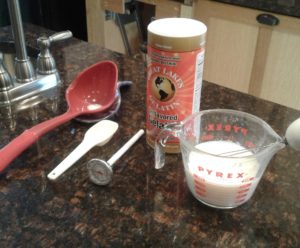
Pour this mixture and the rest of the milk into the pan.
– Warm the milk over medium heat. Stir occasionally with a whisk. You shouldn’t need to stir constantly. Heating to between 170° and 180° is sufficient. This takes approximately 30 minutes. Watch more carefully once it gets past 130°. It will go more quickly from there. Do not allow the milk to boil!
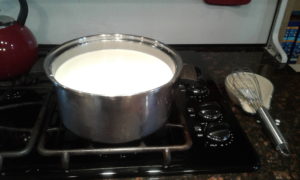
– Once the milk reaches the desired temperature, set the pan in the sink. Fill the sink with cold water up to the level of the milk. Stir and let cool. It won’t take long for the hot milk to warm the surrounding water. I drain the sink and refill with cold water once. Let the milk cool to 100° – 115°.
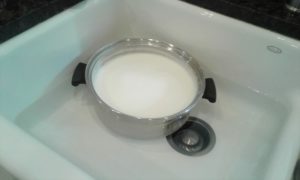
– Put some of the wam milk into the small bowl and whisk in a spoonful of cultured yogurt or the starter culture. Whisk until smooth, then pour this back into the milk and whisk to incorporate it throughout.
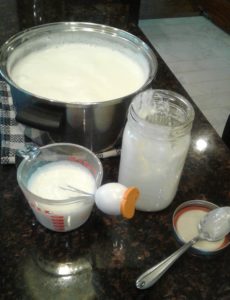
– Ladle the milk into clean jars. I get a full 5 quarts from a gallon of milk. Put lids on the jars. They will seal themselves a bit when they cool, but you aren’t trying for a permanent seal. I use the same lids over and over, as long as there aren’t signs of rust.
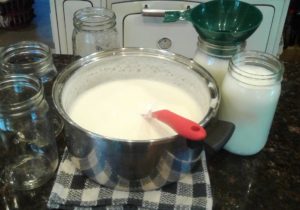
– Set the jars in the container you are using for incubation. Fill the container with hot tap water up to the necks of the jars.
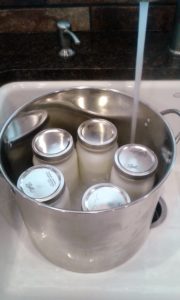
– Cover the container and set it on the heating pad to let the yogurt incubate at 100° for 6 – 8 hours. You will need to check the water temperature periodically, and adjust the heating pad setting if it is getting too cool or too hot. The goal is to keep the temperature between 90° and 100°.
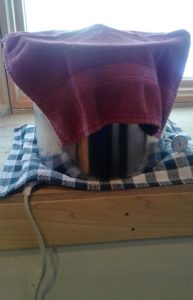
Note: If your heating pad is relatively new, chances are good that it has an automatic shut-off, after 2 hours or so. Mine is old enough that it doesn’t do that, but if yours does, simply set a timer so you can turn it off, then back on.
You should not disturb the jars while they incubate, but when you think it is done, you can tip one a little to see if the yogurt has thickened. Don’t worry if it’s not quite what you want the finished product to be. It will thicken more once it’s chilled.
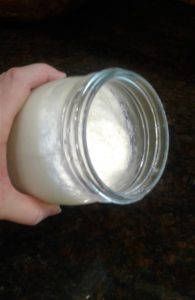
On the one occasion where I didn’t end up with anything resembling yogurt, I think I kept the incubation temperature too high. Instead, I got 2 quarts of whey and several cups of curds that could have been used in place of ricotta cheese. I told my grandkids, “All we need now is a tuffet.” https://www.amazon.com/Fairfield-Soft-Support-Cushion-Tuffet/dp/B01MG6EXD4/ref=sr_1_4?ie=UTF8&qid=1549061857&sr=8-4&keywords=tuffet
Once it is chilled, you can sweeten it with honey, or add fruit. You may want to thicken the juice from the fruit with gelatin to keep from thinning the yogurt too much. If you started with a gallon of milk, you now have 5 quarts of yogurt to experiment with flavors.